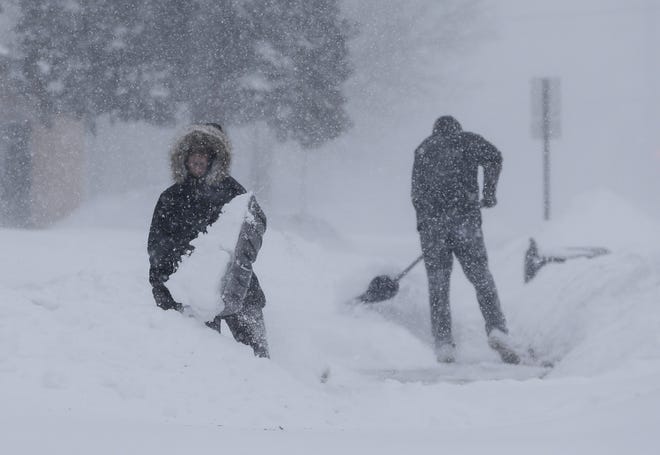Is Wisconsin in for a 'polar coaster' this winter? Here's what the experts say
 Madeline Heim
Madeline Heim
As a pleasant summer draws slowly to a close, the 2020 Farmers' Almanac released a prediction Monday that would send a chill through even the most hearty Wisconsinite's bones.
The periodical's secret formula called for a "polar coaster," its website promising "another winter ride, full of thrills and chills."
That means above-normal winter precipitation over the Midwest and temperatures plunging across the northern Plains into the Great Lakes region. For those of us who remember last winter's volatility, it certainly seems foreboding.
But what sort of stock can be put into the Almanac's prediction? How much should we fear this impending polar coaster?
RELATED: This is not normal. Central, northeast Wisconsin have set 11 daily weather records this winter
RELATED: Suntanning, roof sledding among the funny ways Wisconsinites are coping with winter
Wisconsin's weather experts say not so much.
"The weather part of (the Farmers' Almanac) is a joke," said Jonathan Martin, professor of atmospheric and oceanic sciences at the University of Wisconsin-Madison. "It's good for their marketing, but there's no science behind it."
It's easy to make general predictions about what a winter will be like based on a region's climatology, or the study of its weather patterns over a long range of time, Martin said. For example, the website warns that the coldest part of winter will run from the last week in January to early February.
So when the Almanac predicts outbreaks of cold air and periods of heavy snow, it will appear accurate — because frankly, that's winter in Wisconsin.
"It's not a good forecast. It's climatology," Martin said. "They don't have any way to give you information that you can't get yourself."
Once forecasters get outside the 10-day mark for predicting weather patterns, all predictions are based on the probability of being above or below normal, said Jim Skowronski, a National Weather Service meteorologist based in Green Bay.
The NWS' general predictions for this winter, for example, are for a slightly better chance of above-normal precipitation and "equal chances" for temperatures, meaning there's not yet enough indication of temperatures being above or below normal, Skowronski said. A more in-depth outlook is typically released in the fall.
"Just like a wave in the ocean, we have waves in the atmosphere that produce the weather we experience," said Jeff Last, warning coordination meteorologist at the NWS office in Green Bay. "The predictability of these waves becomes more difficult beyond a week or two."
So how do forecasters make predictions about how a given winter will look? It's about studying global weather patterns, like El Niño and La Niña, that impact long-term seasonal outlooks, Last said.
This year, forecasters are predicting neutral conditions, rather than a weather event like an El Niño, Last said, which actually means winter weather across the northern hemisphere will be more unpredictable.
But even so, he added, every winter is going to have some cold air, some snowstorms and some mild weather.
And even a winter like we saw last year means little in terms of what could be coming next.
"The atmosphere has a very, very short memory," Martin said. "Last winter will have no bearing at all on this winter."
That makes it nearly impossible to determine whether the events of a single winter are effects of climate change, Last said.
But there are indicators of the effects of a warming planet that climate scientists like Martin are mulling, like how much arctic sea ice disappears by the end of melt season in mid-September.
Less sea ice means there's more open ocean for cold air to blow across, Martin said, creating an earlier snowfall season in parts of Russia, Siberia and Mongolia. That in turn produces cold air masses more easily over those locations, which makes us susceptible to a more frequent influx of those masses.
In effect, the jury is still out on whether a warming climate will mean more winter ups and downs.
But as for the Farmers' Almanac's prediction of the "polar coaster"? We can rest easy knowing there's nothing to suggest anything other than a regularly crappy Wisconsin winter.
"(The polar coaster) may well be true. We may end up with a winter like that," Martin said. "But it won't be confirmation of a good forecast. It'll just be luck."
Contact Madeline Heim at 920-996-7266 or mheim@gannett.com. Follow her on Twitter at @madeline_heim.